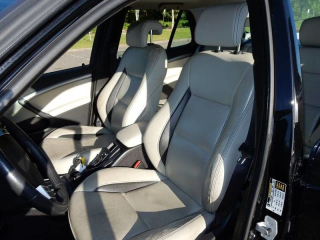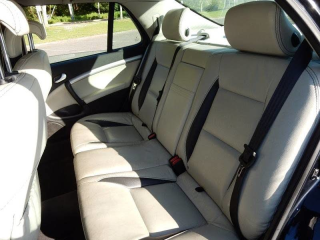The Good
The 2008 Saab 9-5 boasts strong turbocharged performance and exceptional long-distance comfort, particularly its highly regarded seats. Its unique, understated Scandinavian design appeals to emotional buyers seeking distinction. Practically, it offers a spacious cabin (especially the SportCombi), solid safety features, and, as a used car, represents significant value, providing premium features for a modest price. Efficiency is decent for its class and power.
The Bad
Known weaknesses for the 2008 Saab 9-5 include potential issues with the Positive Crankcase Ventilation (PCV) system leading to oil sludge, failure of the Direct Ignition (DI) Cassette, vacuum line leaks affecting performance, and the infamous Saab Information Display (SID) pixel degradation. Suspension components can also wear over time, requiring attention.
2008 Saab 9-5: Quick Overview
- Engine Option: For the US market in 2008, the 9-5 exclusively featured a robust 2.3-liter (B235R) turbocharged 4-cylinder engine. This was a streamlined approach from previous years, effectively standardizing the Aero-level powerplant across the lineup.
- Horsepower: The 2.3L turbocharged engine produced a healthy 260 horsepower and 258 lb-ft of torque. This provided brisk acceleration and strong passing power for its class.
- Fuel Economy (EPA Est.):
- Sedan (Automatic): Approximately 19 MPG City / 26 MPG Highway
- SportCombi (Wagon, Automatic): Approximately 18 MPG City / 26 MPG Highway
- 0-60 Times: With the 260 hp engine and standard 5-speed automatic transmission, the 2008 9-5 sedan and SportCombi were capable of 0-60 mph acceleration in the range of 6.5 to 7.0 seconds, making it quite competitive.
- Towing Capacity: While not a primary selling point in the US, the 2008 Saab 9-5 typically had a modest towing capacity. When properly equipped, it could handle approximately 1,500 to 2,000 lbs, although it was generally not recommended for heavy towing in North America. European ratings were higher.
- Trim-Level Features: In 2008, Saab largely simplified the 9-5 lineup, essentially offering one well-equipped model that was comparable to the former Aero trim. Standard features included:
- 2.3L 260 hp Turbocharged engine
- 5-speed Sentronic automatic transmission
- Standard leather upholstery with heated front and rear seats
- Dual-zone automatic climate control
- Xenon headlights with automatic leveling
- Harman Kardon premium audio system
- 17-inch alloy wheels
- Saab Information Display (SID)
- Night Panel feature for reduced dashboard illumination
- Power glass moonroof
- OnStar communication system
- Cruise control
- Power windows, locks, and heated mirrors
- Traction control and Electronic Stability Program (ESP)
- Optional features typically included a DVD-based navigation system and metallic paint.
2008 Saab 9-5 Specifications
Vehicle Information
| Year | 2008 |
| Make | Saab |
| Model | 9-5 |
| Trim | - |
| Style | 2.3-T |
| Type | Sedan |
| Category | Mid-Size Station Wagon |
Manufacturing Details
| Made In | Sweden |
| Manufacturing City | TROLLHATTAN |
Dimensions
| Doors | 4-Door |
| Curb Weight | 3530 pounds |
| Gross Vehicle Weight Rating | - |
| Overall Height | 57.20 inches |
| Overall Length | 190.40 inches |
| Overall Width | 70.50 inches |
| Wheelbase Length | 106.40 inches |
| Standard Seating | 5 |
Engine & Performance
| Engine | 2.3-L L-4 DOHC 16V Turbo |
| Engine Size | 2.3L |
| Engine Cylinders | 4 |
| Transmission | 5-Speed Automatic |
| Transmission Type | Automatic |
| Transmission Speeds | 5-Speed |
| Drivetrain | Front-Wheel Drive |
Additional Features
| Anti-Brake System | 4-Wheel ABS |
| Steering Type | Rack & Pinion |
Pricing
| Manufacturer Suggested Retail Price (MSRP) | $37,200 |
| Invoice Price | $35,154 |
| Delivery Charges | $775 |
Vehicle History Report
Specifications
History
Events
History Check
Check
Check
Check
Check
Listings
Recalls
Check
Analysis
What Problems Does the 2008 Saab 9-5 Have?
Another common problem is the failure of the Direct Ignition (DI) Cassette, which houses the ignition coils. This component is prone to heat-related stress and can cause misfires, rough idling, and engine warning lights. Replacement is straightforward but can be costly. Turbocharger longevity is also directly tied to proper oil maintenance; neglected oil changes or a failing PCV system significantly increase the risk of turbo failure.
Electrical gremlins are not uncommon. The Saab Information Display (SID) is notorious for pixel degradation, leading to unreadable text. Window regulators can fail, and various sensors or vacuum lines can leak, affecting engine performance and boost pressure. Suspension components, particularly control arm bushings and tie rod ends, will wear out over time, leading to clunks and imprecise handling. The air conditioning system's blend door actuators can also fail.
Regarding recalls, the 2008 model year itself had relatively few major safety recalls compared to earlier 9-5 models (which had recalls for ignition switches or fuel pump modules). However, it benefited from service bulletins addressing issues like the PCV system updates. Long-term ownership concerns often revolve around parts availability, though many common wear items are still readily available through aftermarket suppliers or Saab parts specialists. Finding skilled mechanics familiar with Saab's unique engineering can also be a challenge in some regions, contributing to higher labor costs and potential for misdiagnosis. Prospective buyers should always seek out a model with a documented service history.
How long will the 2008 Saab 9-5 last?
However, weaknesses emerge over time. Electrical components like the SID and window regulators often fail. Suspension bushings and steering components naturally wear out. The turbocharger, if subjected to poor oil circulation or infrequent changes, can be a major expense. Rust can also become a concern in regions using road salt. Overall, while the underlying structure and powertrain are robust, diligent maintenance is essential to avoid costly issues as the car ages.
What Technology & Safety Features are Included?
For entertainment, the 2008 model came standard with a premium Harman Kardon audio system, typically featuring an AM/FM radio and an in-dash CD player, sometimes with a multi-disc changer. While Bluetooth streaming was not native, some models had an auxiliary input or could be retrofitted. An OnStar communication system was also standard, offering emergency services and navigation assistance (with subscription).
Driver-assistance features were more basic compared to modern vehicles. Cruise control was standard, and some models might have included rear parking sensors as an option or standard feature. More advanced systems like blind-spot monitoring or adaptive cruise control were not available.
Saab's reputation for safety was upheld by the 9-5. Standard safety features included:
- Anti-lock Brakes (ABS)
- Electronic Brake-force Distribution (EBD)
- Traction Control System (TCS)
- Electronic Stability Program (ESP)
- Multiple airbags, including front, side-impact, and side-curtain airbags
- Saab's innovative Active Head Restraints (SAHR), designed to reduce whiplash injuries
- Front seatbelt pre-tensioners and load limiters
What Colors Options are Available?
2008 Saab 9-5 Prices and Market Value
Today, the used market prices for a 2008 Saab 9-5 are significantly lower, primarily due to its age and the brand's defunct status. Well-maintained examples in good condition typically sell for $3,000 to $8,000, while average condition cars can be found for $1,500 to $4,000. Exceptional, low-mileage SportCombi or Aero-spec models might occasionally fetch slightly more from enthusiasts.
Depreciation has been steep, as expected for a luxury vehicle over 15+ years, exacerbated by Saab's bankruptcy. Factors affecting current resale value include comprehensive service records, overall cosmetic and mechanical condition, mileage, and the specific trim (the 2008 model was essentially Aero-spec, making it desirable). The more rare SportCombi tends to hold its value better among enthusiasts. Perceived parts availability and the need for specialized mechanics also depress prices for non-enthusiasts, who may view it as a riskier purchase.
2008 Saab 9-5 Cost of Ownership
2008 Saab 9-5 Fuel Efficiency
2008 Saab 9-5 Safety Rating
NHTSA
IIHS
2008 Saab 9-5 Warranty
Basic
Powertrain
Rust
2008 Saab 9-5 Insurance
reasonable repair costs.
How Does the 2008 Saab 9-5 Compare to Other Sedan?
In terms of performance, the 9-5's 260hp turbocharged 4-cylinder offered strong, accessible torque, making it a capable highway cruiser and good for spirited daily driving. However, rivals like the BMW 335i/535i often provided more refined inline-six power and superior driving dynamics, particularly in handling and steering feel. Audi's Quattro AWD gave it an edge in adverse weather, and their engines could also be quite potent.
Regarding features, the 9-5 was exceptionally well-equipped for 2008, essentially mirroring the Aero trim with standard leather, heated front and rear seats, a Harman Kardon audio system, and Xenon headlights. Its unique "Night Panel" and ergonomic cockpit design were distinct. While rivals offered similar luxury amenities, some might have had more advanced infotainment or slightly more contemporary interior designs. Saab's interior appeal is highly subjective due to its unique layout.
Reliability is where the 9-5 presents a mixed bag. It has known specific issues (PCV, DI cassette, SID pixels) that, if neglected, can be costly. While German rivals also have their own complex and expensive failure points (e.g., cooling systems in BMWs, electronic issues in Mercedes), Japanese luxury cars like the Acura TL or Infiniti G35 generally had a stronger reputation for long-term dependability, albeit with less "character."
In terms of price, the 2008 9-5 is now significantly cheaper in the used market than its European counterparts from the same year, a direct consequence of Saab's dissolution. This makes it an attractive proposition for buyers seeking luxury features on a budget, provided they are prepared for potential maintenance costs.
Similar Alternatives:
- Volvo S60/V70 (early 2000s): Offers similar Scandinavian design, safety focus, and turbocharged engines, often at comparable used prices.
- Lexus ES/GS (older models): For buyers prioritizing reliability and a smooth, quiet ride over European driving dynamics.
- BMW 330i/335i (E90) or 530i/535i (E60): For superior driving engagement and more modern powertrains, though often with higher initial used purchase prices and similar, if not greater, maintenance complexities.
- Audi A4/A6 (B7/C6 generation): For those desiring Quattro all-wheel drive, refined interiors, and a more understated German luxury experience.
Final Verdict: Is the 2008 Saab 9-5 a Good Sedan?
Is it worth buying? Yes, but with significant caveats. It is definitely a used-only purchase, and given its age and the brand's status, it represents excellent value for money in terms of features and initial purchase price. However, prospective buyers must be prepared for potentially higher long-term ownership costs related to specialized maintenance and repairs, particularly if service history is poor. It's crucial to find a model with comprehensive service records, especially regarding the PCV system and oil changes, and to budget for a thorough pre-purchase inspection by a Saab specialist. The 2008 model, essentially being a highly equipped Aero-spec, offers a great package. The SportCombi (wagon) variant is particularly desirable for its added utility and rarity, often commanding a slight premium among enthusiasts. It's not for the faint of heart, but incredibly rewarding for those willing to commit to its care.

